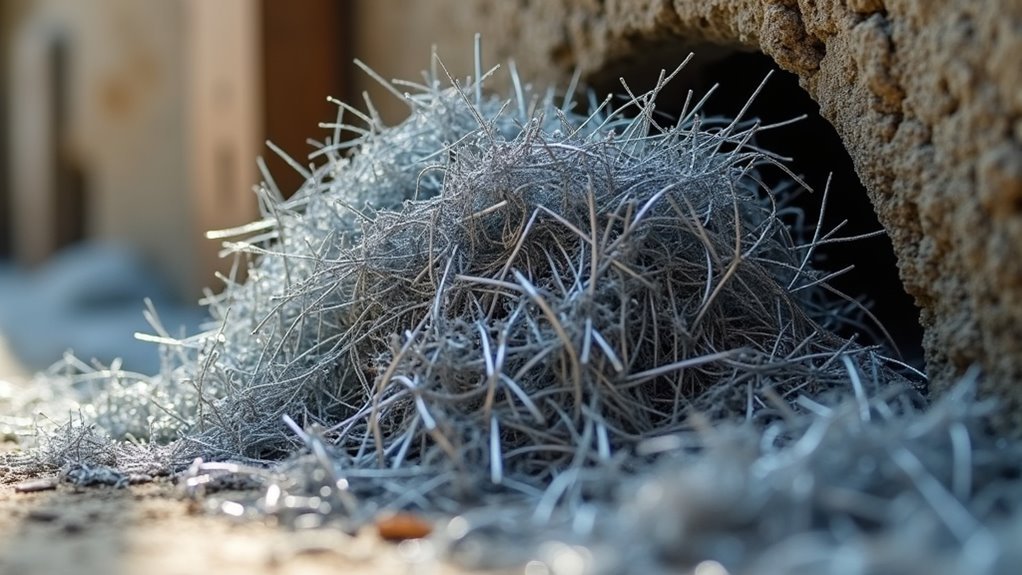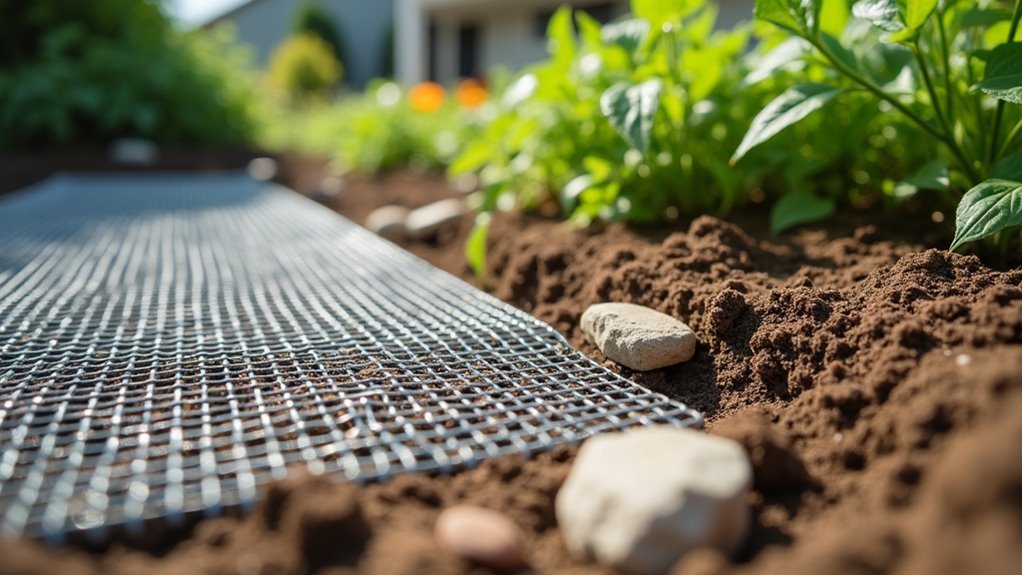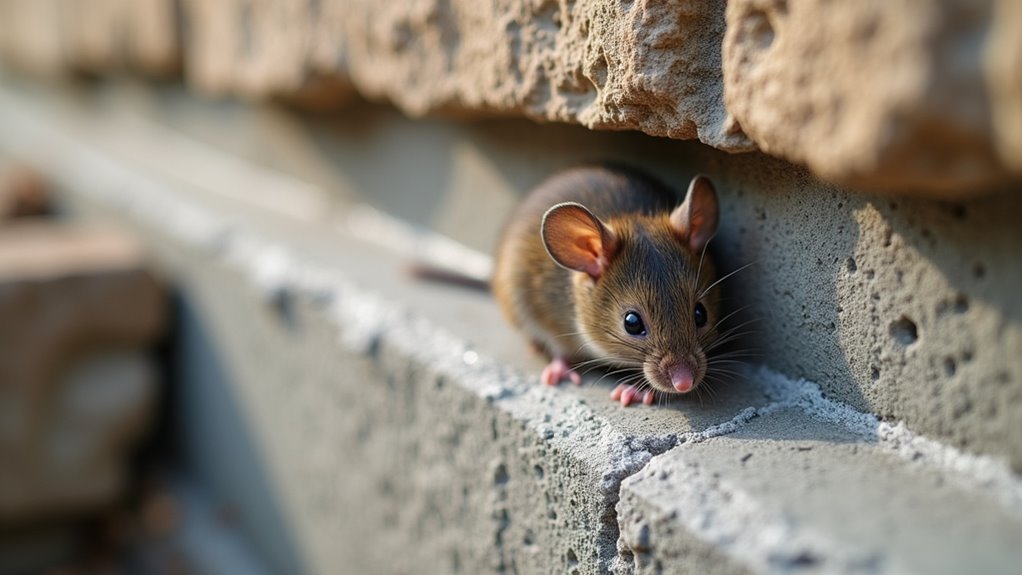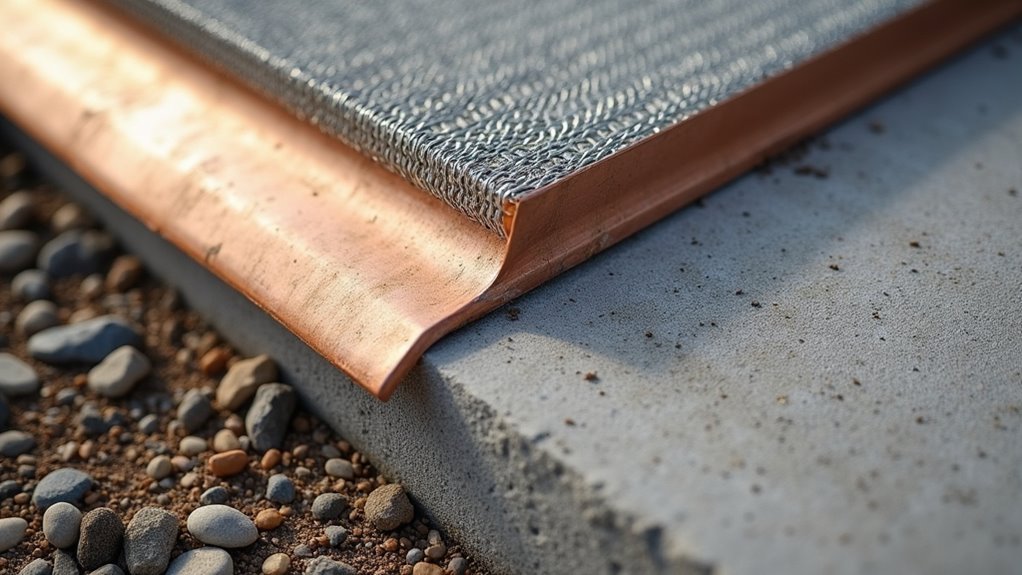You’ll need steel wool or copper mesh to effectively seal foundation cracks larger than 1/4 inch, as mice can’t chew through these coarse materials. Hardware cloth works well for bigger openings when buried 6-12 inches below ground level. Expandable spray foam fills irregular gaps, but you should combine it with steel wool for maximum protection. High-quality rodent-resistant caulks handle smaller cracks under 1/4 inch. Proper installation and regular inspections guarantee these barriers maintain their effectiveness against determined rodents.
Steel Wool as Primary Barrier Material

When it comes to blocking mice from entering your foundation, steel wool stands out as one of the most reliable primary barrier materials you can use. Its coarse texture makes it nearly impossible for mice to chew through, effectively sealing entry points that would otherwise allow access to your home.
You’ll want to focus on gaps around pipes, foundation cracks, and any openings measuring 1/4 inch or larger, since mice can squeeze through surprisingly small spaces.
For maximum effectiveness, combine steel wool with caulking to create a durable, long-lasting seal that will prevent rodents from finding alternative routes.
Remember to inspect these barriers regularly, as wear and settling can create new vulnerabilities over time.
Copper Mesh for Long-Term Durability
You’ll find copper mesh offers superior longevity compared to steel wool because it won’t rust or corrode over time.
This rust-resistant quality prevents staining around entry points while maintaining the barrier’s structural integrity for years.
When you’re ready to install copper mesh, proper placement techniques guarantee you’ll achieve maximum effectiveness in sealing foundation gaps.
Rust-Resistant Properties
One of copper mesh’s greatest advantages lies in its exceptional resistance to rust and corrosion, making it the superior choice for long-term foundation protection against mice.
Unlike steel wool that deteriorates rapidly when exposed to moisture, copper mesh maintains its structural integrity for years without weakening. This rust-resistant property guarantees your rodent entry barriers won’t fail during wet seasons or in humid basement environments.
You’ll find that copper mesh’s corrosion resistance translates into cost savings over time. While initial investment might be higher than alternatives, you won’t need frequent replacements.
The material withstands harsh weather conditions, temperature fluctuations, and moisture exposure without compromising its effectiveness. These rust-resistant properties make copper mesh particularly valuable for foundation applications where long-term reliability is essential for preventing mouse infestations.
Professional Installation Methods
Professional installers maximize copper mesh effectiveness by combining proper placement techniques with complementary sealing materials to create impenetrable rodent barriers.
You’ll find that experts cut and shape copper mesh precisely to fit openings around foundations, vents, and pipes. They tightly pack the material into gaps larger than 1/4 inch, ensuring no entry points remain accessible to mice.
During professional installation, contractors often pair copper mesh with high-quality sealants or expanding foam to enhance long-term performance.
This dual approach prevents the mesh from shifting over time while maintaining structural integrity. Unlike DIY attempts, professional rodent control services use specialized tools to secure copper mesh deep into crevices, creating permanent solutions that withstand weather exposure and potential tampering from persistent rodents.
Hardware Cloth Installation Methods

Installing hardware cloth requires three essential steps to create an effective mouse barrier around your foundation.
First, identify all potential entry points where rodents could squeeze through gaps larger than 1/4 inch. Measure these openings carefully to determine how much hardware cloth you’ll need.
Second, prepare the galvanized steel mesh by cutting it to size, ensuring you have enough material to bury 6-12 inches below ground and extend vertically above any openings. This prevents burrowing underneath your barrier.
Third, secure the hardware cloth using staple guns for wooden structures or concrete anchors for masonry.
Overlap seams by at least one inch and reinforce connections with wire ties. Create tight fits without gaps to maximize effectiveness against mouse intrusion.
Expandable Spray Foam Applications
Seal foundation cracks and gaps effectively with expandable spray foam, a versatile material that creates an impenetrable barrier against mouse intrusion.
You’ll find this foam particularly useful for filling entry points larger than 1/4 inch, where traditional caulking falls short. The foam expands to fill voids completely, creating a dense barrier that’s difficult for mice to gnaw through.
Apply the foam carefully to prevent over-expansion, which can damage surrounding materials. For maximum rodent-proofing effectiveness, combine expandable spray foam with steel wool or copper mesh at particularly vulnerable entry points. This combination approach strengthens your foundation’s defenses considerably.
Always allow the foam to cure completely before painting or sealing over it, as uncured foam remains susceptible to rodent damage.
High-Quality Sealants and Caulks

You’ll find that high-quality sealants outperform standard caulks when blocking mice entry points, as they bond more effectively and resist rodent chewing.
These specialized formulas contain rodent-resistant properties that make them considerably harder for mice to gnaw through compared to basic household caulks.
Your application technique becomes critical when using these materials, especially for gaps larger than 1/4 inch where proper preparation and layering determine long-term effectiveness.
Sealant Vs Caulk Performance
When comparing high-quality sealants to standard caulks for rodent exclusion, you’ll find that sealants consistently outperform caulk in durability and resistance to mouse damage.
Here’s why sealant proves superior for preventing rodent entry:
- Stronger bonding properties create a more durable barrier that withstands environmental stress and temperature fluctuations.
- Enhanced chew resistance makes mice less likely to gnaw through the material compared to standard caulks.
- Better flexibility allows sealants to accommodate structural movement without cracking over time.
- Specialized formulations often include deterrent materials like copper mesh or additives specifically designed to discourage chewing.
While caulk works adequately for small gaps under 1/4 inch, you should choose high-quality sealants for larger openings and areas requiring maximum protection against persistent mice.
Rodent-Resistant Formula Properties
Modern rodent-resistant formulas incorporate specific chemical and physical properties that make them considerably more effective than standard sealing materials.
You’ll find these high-quality sealants contain additives that create stronger bonds and enhanced durability against environmental factors. The enhanced formulation resists degradation from moisture, temperature changes, and UV exposure that typically weaken standard products.
When you combine these advanced sealants with materials like copper mesh or steel wool, you’re creating a multi-layered defense system.
The improved adhesion properties guarantee these backing materials stay securely in place. You can’t rely on foam alone since mice easily chew through it, but rodent-resistant sealants maintain their integrity against gnawing.
These specialized formulas cure harder and more flexible than conventional options, preventing cracking that creates new entry points.
Proper Application Techniques
Understanding these superior formula properties means nothing without proper application techniques that maximize their effectiveness.
You’ll need to follow a systematic approach when sealing foundation gaps to guarantee lasting rodent-proofing results.
Here’s the proven three-step process for applying sealants:
- Fill gaps with steel wool or backing material to create a solid foundation
- Insert exclusion materials like copper mesh or Xcluder fabric into larger openings
- Apply high-quality sealant over everything to create an impenetrable barrier
- Cover foam sealants with solid materials since foam alone isn’t rodent-resistant
Remember that sealants bond better to clean, dry surfaces.
You must also inspect and maintain these entry points regularly, as weathering can compromise your barriers and create new vulnerabilities for determined mice.
Mortar and Concrete Repair Solutions
Since foundation cracks and deteriorated mortar joints create perfect entry points for mice, you’ll need proper repair materials and techniques to seal these vulnerabilities permanently. When dealing with badly deteriorated foundation mortar, tuck pointing becomes essential – you must remove old mortar completely to guarantee proper adhesion of new material.
| Gap Size | Indoor Solution | Outdoor Solution | Backing Required | Durability |
|---|---|---|---|---|
| Under 1/4″ | High-quality sealant | High-quality sealant | No | Long-term |
| Over 1/4″ | Steel wool + sealant | Copper mesh + sealant | Yes | Long-term |
| Large cracks | Exclusion fabric layers | Galvanized sheet metal | Yes | Permanent |
| Temporary fix | Steel wool only | Not recommended | No | Short-term |
| Small gaps | Rodent-resistant sealant | Rodent-resistant sealant | No | Long-term |
Regular inspection and maintenance guarantee your repairs remain effective against rodent entry.
Galvanized Sheet Metal Protection
When standard sealants and mesh materials aren’t sufficient for larger foundation openings, galvanized sheet metal provides the most robust long-term barrier against mouse infiltration.
This durable material withstands rodent gnawing while preventing rust accumulation that could compromise your barrier’s effectiveness.
Follow these essential steps for effective rodent-proofing:
Follow these essential steps for effective rodent-proofing using galvanized sheet metal to create lasting barriers against mouse infiltration.
- Choose the right thickness – Use at least 26-gauge galvanized sheet metal to resist determined gnawing attempts.
- Create tight seals – Overlap all seams and secure with screws to eliminate potential entry points.
- Custom fit irregular spaces – Cut and shape metal to match foundation gaps perfectly.
- Schedule regular inspections – Check for damage or deterioration that could allow mouse infiltration.
You’ll find galvanized sheet metal particularly effective for covering larger holes, damaged foundation sections, and areas where traditional materials fail.
Wire Mesh for Ventilation Areas
While galvanized sheet metal works well for sealing larger openings, ventilation areas require a different approach that maintains airflow while blocking mouse entry.
Wire mesh provides the perfect solution for these spaces, allowing necessary air circulation while creating an effective barrier.
Choose galvanized hardware cloth or welded-wire mesh with openings no larger than 1/4 inch to prevent mice from squeezing through.
Install the wire mesh securely over ventilation openings, adding crossbars on larger areas for structural support and chewing resistance.
Regular maintenance guarantees long-term effectiveness.
Inspect your mesh monthly, removing accumulated dust and debris that could restrict airflow.
Use rust-resistant materials to minimize replacement needs and maintain consistent protection throughout seasons.
Xcluder Fabric Technology
Although traditional materials like steel wool can provide temporary rodent control, Xcluder Fabric Technology offers a revolutionary approach that combines durability with effectiveness.
This innovative fabric blends stainless steel with poly fibers, creating an impenetrable barrier that’ll stop mice from accessing your foundation.
Here’s why you’ll benefit from using Xcluder Fabric:
- Weather resistance – withstands harsh conditions without degrading
- Easy customization – cuts and shapes to fit any opening size
- Corrosion-proof – unlike steel wool, it won’t rust or deteriorate
- Proven effectiveness – blocks even the tiniest entry points
You can rely on this material to provide permanent protection against rodent intrusion.
Its flexibility makes installation simple, while the stainless steel construction ensures mice can’t gnaw through your defenses.
Foundation Crack Filling Materials
You’ll need specific materials to permanently seal foundation cracks and prevent mice from exploiting these vulnerable entry points.
Concrete and mortar solutions form the backbone of crack repair, while metal mesh reinforcement adds an extra layer of protection that rodents can’t chew through.
Professional sealant applications guarantee long-lasting results when you’re dealing with larger gaps or complex foundation issues.
Concrete and Mortar Solutions
When foundation cracks and deteriorated mortar create entry points for mice, concrete and masonry solutions provide the most durable long-term barriers.
For effective rodent exclusion, you’ll need these concrete and mortar approaches:
- Concrete repair – Use concrete or masonry grout for foundation cracks, creating an impenetrable barrier that mice can’t chew through or squeeze past.
- Tuck pointing – Replace badly deteriorated foundation mortar with fresh mortar to guarantee proper adhesion and seal larger gaps effectively.
- Steel wool reinforcement – While steel wool rusts outdoors, you can use it temporarily in small gaps before applying permanent concrete solutions.
- Layered approach – Combine materials strategically, using steel wool as backing and sealing with concrete or mortar for maximum durability.
These masonry solutions create permanent barriers that withstand weather and rodent attempts.
Metal Mesh Reinforcement
For larger foundation openings where concrete alone isn’t practical, metal mesh reinforcement creates a robust barrier that combines structural support with rodent deterrence. Galvanized hardware cloth or welded-wire mesh effectively blocks access points in foundation walls, preventing mice from squeezing through cracks and gaps.
| Mesh Type | Best Use | Installation Method |
|---|---|---|
| Hardware Cloth | Small to medium cracks | Anchor securely, seal edges |
| Welded-Wire Mesh | Large openings | Cut to fit, overlap joints |
| Steel Wool (fine mesh) | Tiny gaps | Stuff tightly, coat with sealant |
When combined with quality sealants, metal mesh resists rodent gnawing while providing structural reinforcement. You’ll need to anchor the mesh securely and cover it completely with sealing compound. Inspect regularly for rust or deterioration that could compromise effectiveness.
Professional Sealant Applications
Professional sealants provide superior protection against rodent entry compared to basic caulking materials, especially when filling foundation cracks larger than 1/4 inch.
These high-grade materials bond more effectively and resist rodent chewing, making them essential for long-term rodent-proofing.
When addressing foundation entry points, consider these professional applications:
- High-quality sealants for cracks exceeding 1/4 inch that offer superior adhesion and durability
- Tuck pointing with matching mortar for deteriorated foundation areas requiring structural repair
- Foam sealants with protective coverings since exposed foam isn’t rodent-proof
- Copper mesh integration with sealants to create impenetrable barriers at vulnerable spots
Regular maintenance and inspection remain critical, as new gaps can develop over time, potentially compromising your rodent-proofing efforts.
Maintenance and Inspection Requirements
Five critical maintenance tasks will keep your foundation’s mouse barriers working effectively year-round.
First, regularly inspect your foundation for cracks and gaps larger than 1/4 inch, as these create entry points for mice entering your home.
Second, maintain a clean, weed-free perimeter around your foundation to discourage rodent burrowing and nesting activities.
Third, schedule periodic evaluations of existing sealants and barriers, replacing worn or damaged areas immediately.
Fourth, check vents, windows, and exterior doors to properly seal any gaps exceeding 1/2 inch.
Finally, implement an integrated pest management program that includes routine monitoring for rodent activity signs.
These inspection requirements guarantee your mouse-proofing materials maintain their effectiveness and prevent costly re-infestations through compromised barriers.
Frequently Asked Questions
What Can I Put Around Foundation to Keep Mice Away?
You can install galvanized sheet metal around your foundation’s entry points, fill gaps with copper mesh, apply quality sealants to cracks, and maintain crushed rock perimeters that discourage burrowing.
What Material Can Mice Not Get Through?
You can’t go wrong with galvanized sheet metal, copper mesh, or hardware cloth with 1/4-inch openings. These materials resist gnawing and provide lasting protection that mice simply can’t chew through effectively.
How Do I Stop Mice From Digging Under My Foundation?
Extend your foundation walls 36 inches below ground and surround them with 18 inches of compacted sharp gravel. This creates a solid barrier that discourages burrowing while providing proper drainage.
What Material Repels Mice?
You can repel mice using strong scents like peppermint oil, eucalyptus oil, and cayenne pepper. Chemical odors such as ammonia, bleach, and mothballs also effectively deter them from approaching treated areas.
In Summary
You’ve got multiple effective options to seal your foundation against mice. Steel wool and copper mesh provide immediate barriers, while hardware cloth and Xcluder fabric offer durable long-term solutions. Don’t forget to combine these with quality sealants and spray foam for complete coverage. Remember, you’ll need to inspect and maintain these barriers regularly since mice constantly search for new entry points. Choose materials based on your specific foundation type and vulnerability areas.





Leave a Reply